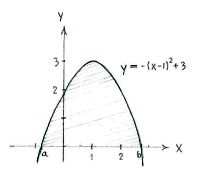Lösung 2.1:4b
Aus Online Mathematik Brückenkurs 2
K (Solution 2.1:4b moved to Lösung 2.1:4b: Robot: moved page) |
|||
| Zeile 1: | Zeile 1: | ||
| - | + | Durch quadratische Ergänzung erhalten wir | |
{{Abgesetzte Formel||<math>\begin{align} | {{Abgesetzte Formel||<math>\begin{align} | ||
| Zeile 8: | Zeile 8: | ||
\end{align}</math>}} | \end{align}</math>}} | ||
| - | + | Wir sehan dass die Funktion ein Parabel mit den Maxima <math>y=3</math> wenn <math>x=1</math> ist. | |
[[Image:2_1_4_b.gif|center]] | [[Image:2_1_4_b.gif|center]] | ||
| - | + | die Fläche die wir bestimmen soll ist im Bild geschattet. | |
| - | + | Diese Fläche bestimmen wir mit den Integral | |
| - | {{Abgesetzte Formel||<math>\text{ | + | {{Abgesetzte Formel||<math>\text{Fläche} = \int\limits_a^b \bigl(-x^2+2x+2\bigr)\,dx\,,</math>}} |
| - | + | Wo ''a'' und ''b'' die Schnittstellen von der Parabel und der ''x''-Achse sind, also die Wurzeln von | |
| - | + | ||
| - | + | ||
| - | + | ||
| - | + | ||
| - | + | ||
{{Abgesetzte Formel||<math>0=-x^{2}+2x+2</math>}} | {{Abgesetzte Formel||<math>0=-x^{2}+2x+2</math>}} | ||
| - | + | oder, durch quadratische Ergänzung (siehe oben), | |
{{Abgesetzte Formel||<math>0=-(x-1)^2+3</math>}} | {{Abgesetzte Formel||<math>0=-(x-1)^2+3</math>}} | ||
| - | + | oder auch | |
{{Abgesetzte Formel||<math>(x-1)^2=3\,\textrm{.}</math>}} | {{Abgesetzte Formel||<math>(x-1)^2=3\,\textrm{.}</math>}} | ||
| - | + | Die Gleichung hat also die Wurzeln <math>x = 1\pm \sqrt{3}\,</math>, und also <math>x=1-\sqrt{3}</math> und <math>x=1+\sqrt{3}\,</math>. | |
| - | + | Die Fläche ist also | |
{{Abgesetzte Formel||<math>\text{Area} = \int\limits_{1-\sqrt{3}}^{1+\sqrt{3}} \bigl(-x^2+2x+2\bigr)\,dx\,\textrm{.}</math>}} | {{Abgesetzte Formel||<math>\text{Area} = \int\limits_{1-\sqrt{3}}^{1+\sqrt{3}} \bigl(-x^2+2x+2\bigr)\,dx\,\textrm{.}</math>}} | ||
| - | + | Wir schreiben hier den Integranden in der quadratisch ergänzten Form. | |
{{Abgesetzte Formel||<math>\text{Area} = \int\limits_{1-\sqrt{3}}^{1+\sqrt{3}} \bigl( -(x-1)^2 + 3\bigr)\,dx\,,</math>}} | {{Abgesetzte Formel||<math>\text{Area} = \int\limits_{1-\sqrt{3}}^{1+\sqrt{3}} \bigl( -(x-1)^2 + 3\bigr)\,dx\,,</math>}} | ||
| - | + | Wir erhalten die die Stammfunktion, | |
{{Abgesetzte Formel||<math>\text{Area} = \Bigl[\ -\frac{(x-1)^3}{3} + 3x\ \Bigr]_{1-\sqrt{3}}^{1+\sqrt{3}}\,\textrm{.}</math>}} | {{Abgesetzte Formel||<math>\text{Area} = \Bigl[\ -\frac{(x-1)^3}{3} + 3x\ \Bigr]_{1-\sqrt{3}}^{1+\sqrt{3}}\,\textrm{.}</math>}} | ||
| - | + | und daher erhalten wir | |
{{Abgesetzte Formel||<math>\begin{align} | {{Abgesetzte Formel||<math>\begin{align} | ||
| Zeile 61: | Zeile 56: | ||
\end{align}</math>}} | \end{align}</math>}} | ||
| - | + | Hinweis: Die Rechnungen werden unständiger wenn wir mit den Ausdruck | |
| - | + | ||
{{Abgesetzte Formel||<math>\int\limits_{1-\sqrt{3}}^{1+\sqrt{3}}{\bigl(-x^2+2x+2 \bigr)}\,dx = \cdots</math>}} | {{Abgesetzte Formel||<math>\int\limits_{1-\sqrt{3}}^{1+\sqrt{3}}{\bigl(-x^2+2x+2 \bigr)}\,dx = \cdots</math>}} | ||
| + | |||
| + | rechnen. | ||
Version vom 18:40, 28. Apr. 2009
Durch quadratische Ergänzung erhalten wir
| \displaystyle \begin{align}
y &= -x^2 + 2x + 2\\[5pt] &= -\bigl(x^2 - 2x- 2\bigr)\\[5pt] &= -\bigl((x-1)^2 - 1^2 - 2\bigr)\\[5pt] &= -(x-1)^2 + 3 \end{align} |
Wir sehan dass die Funktion ein Parabel mit den Maxima \displaystyle y=3 wenn \displaystyle x=1 ist.
die Fläche die wir bestimmen soll ist im Bild geschattet.
Diese Fläche bestimmen wir mit den Integral
| \displaystyle \text{Fläche} = \int\limits_a^b \bigl(-x^2+2x+2\bigr)\,dx\,, |
Wo a und b die Schnittstellen von der Parabel und der x-Achse sind, also die Wurzeln von
| \displaystyle 0=-x^{2}+2x+2 |
oder, durch quadratische Ergänzung (siehe oben),
| \displaystyle 0=-(x-1)^2+3 |
oder auch
| \displaystyle (x-1)^2=3\,\textrm{.} |
Die Gleichung hat also die Wurzeln \displaystyle x = 1\pm \sqrt{3}\,, und also \displaystyle x=1-\sqrt{3} und \displaystyle x=1+\sqrt{3}\,.
Die Fläche ist also
| \displaystyle \text{Area} = \int\limits_{1-\sqrt{3}}^{1+\sqrt{3}} \bigl(-x^2+2x+2\bigr)\,dx\,\textrm{.} |
Wir schreiben hier den Integranden in der quadratisch ergänzten Form.
| \displaystyle \text{Area} = \int\limits_{1-\sqrt{3}}^{1+\sqrt{3}} \bigl( -(x-1)^2 + 3\bigr)\,dx\,, |
Wir erhalten die die Stammfunktion,
| \displaystyle \text{Area} = \Bigl[\ -\frac{(x-1)^3}{3} + 3x\ \Bigr]_{1-\sqrt{3}}^{1+\sqrt{3}}\,\textrm{.} |
und daher erhalten wir
| \displaystyle \begin{align}
\text{Area} &= -\frac{(1+\sqrt{3}-1)^3}{3}+3(1+\sqrt{3}\,)-\Bigl(-\frac{(1-\sqrt{3}-1)^3}{3}+3(1-\sqrt{3}\,)\Bigr)\\[5pt] &= -\frac{(\sqrt{3}\,)^3}{3} + 3 + 3\sqrt{3} + \frac{(-\sqrt{3}\,)^3}{3} - 3 + 3\sqrt{3}\\[5pt] &= -\frac{\sqrt{3}\sqrt{3}\sqrt{3}}{3} + 3\sqrt{3} + \frac{(-\sqrt{3}\,)(-\sqrt{3}\,)(-\sqrt{3}\,)}{3} + 3\sqrt{3}\\[5pt] &= -\frac{3\sqrt{3}}{3} + 3\sqrt{3} - \frac{3\sqrt{3}}{3} + 3\sqrt{3}\\[5pt] &= -\sqrt{3} + 3\sqrt{3} - \sqrt{3} + 3\sqrt{3}\\[5pt] &= (-1+3-1+3)\sqrt{3}\\[5pt] &= 4\sqrt{3}\,\textrm{.} \end{align} |
Hinweis: Die Rechnungen werden unständiger wenn wir mit den Ausdruck
| \displaystyle \int\limits_{1-\sqrt{3}}^{1+\sqrt{3}}{\bigl(-x^2+2x+2 \bigr)}\,dx = \cdots |
rechnen.

